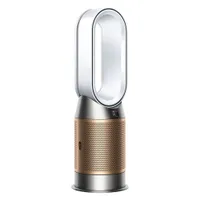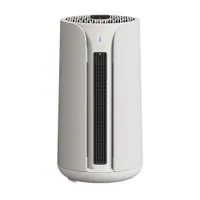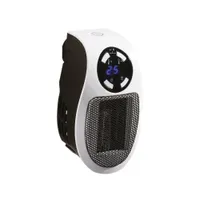I’ve tested the best electric heaters – these are my top picks for when you don’t want to turn the central heating on
The best electric heaters for staying warm, including fan, convector and bladeless indoor heaters from leading brands
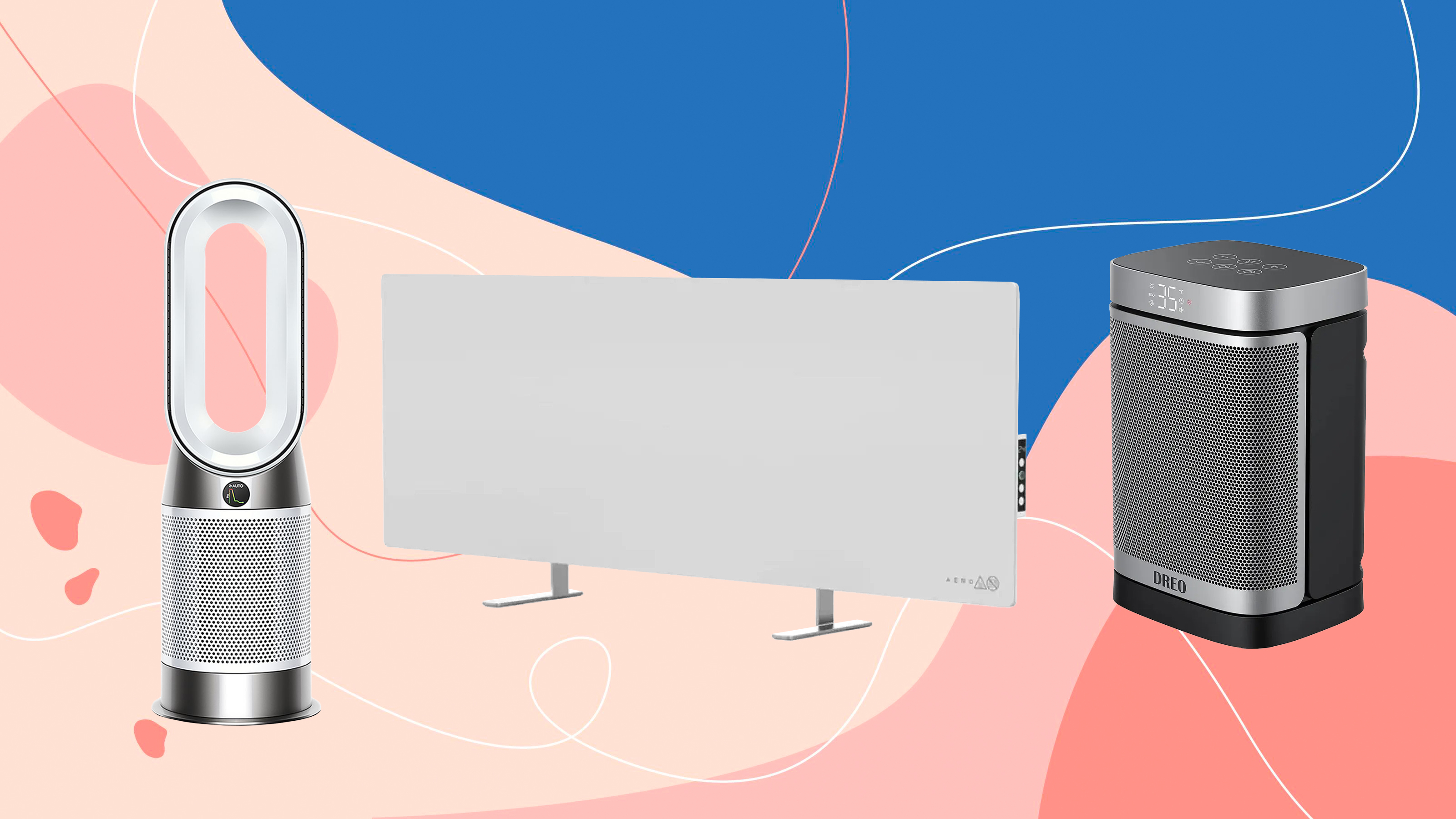

I'm not afraid to admit that I'm pretty stubborn and frugal when it comes to turning the central heating on, and I try to avoid cranking up the thermostat for as long as possible before winter really kicks in. That's why I rely on the best electric heaters to provide a warming and energy-efficient respite from the cold during the autumn months.
But I'm also conscious that there are so many different electric heaters to choose from - from fan heaters to convector heaters and even the best oil-filled radiators. And as I don’t want you to spend your hard-earned money on the wrong choice, the Ideal Home team and I have spent months testing some of the best electric heaters on the market.
As a result, my top choices below are a collection of the best electric heaters you can buy right now, allowing you to heat individual rooms rather than the whole home, and help you save money on your energy bills.
The quick list
Short on time? This quick list is an overview of the very best electric heaters. You'll find more information on each indoor heater and why our testers recommend it if you keep on scrolling.
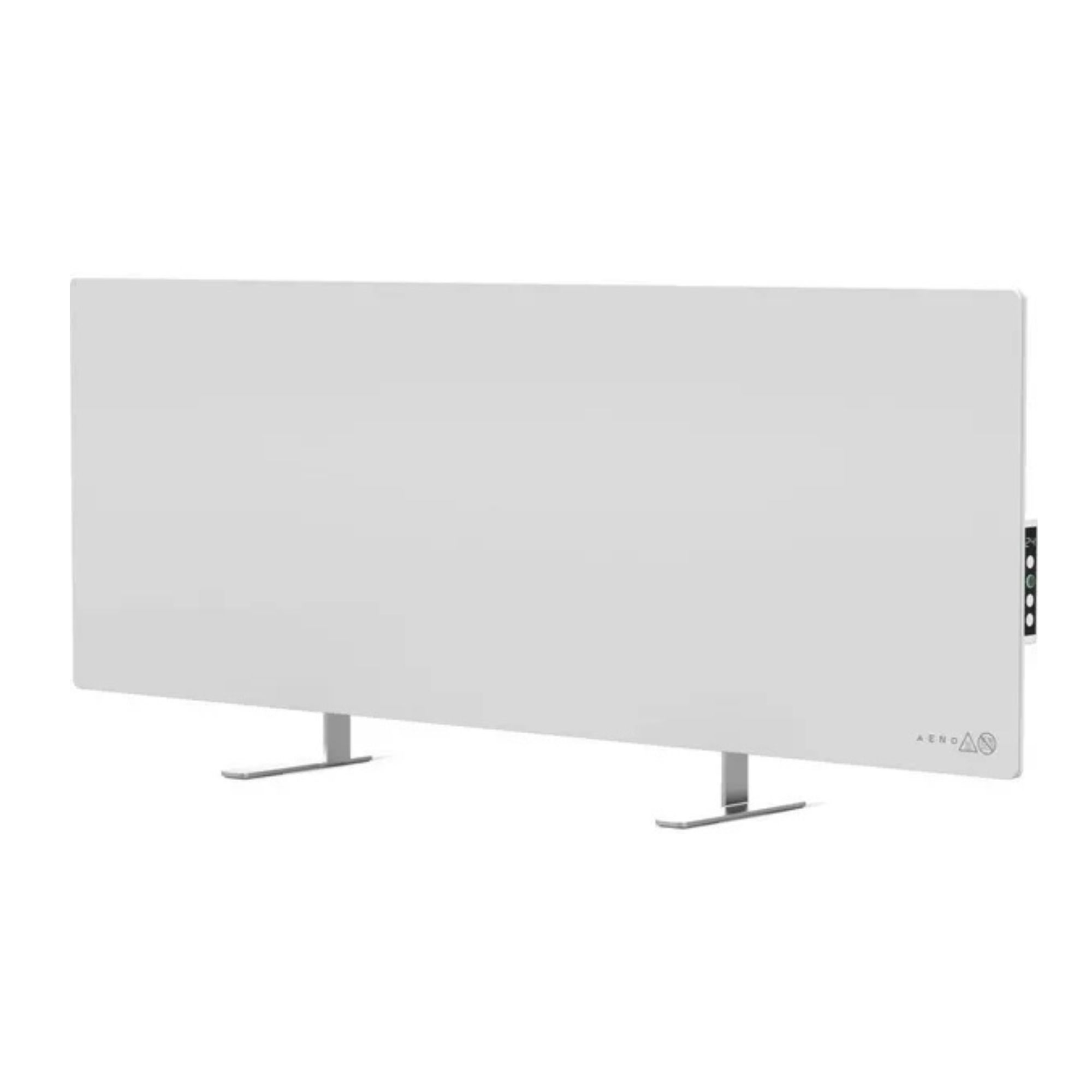
Best electric heater overall
This panel heater uses a mixture of convection/infrared technology to efficiently (and cheaply) heat a home. It offers a sleek and slimline design, and smart functionality, which means you can control everything from the timer to the heat output from your smartphone. It's also completely silent when in use, and can be either wall-mounted or freestanding. It really does have everything.
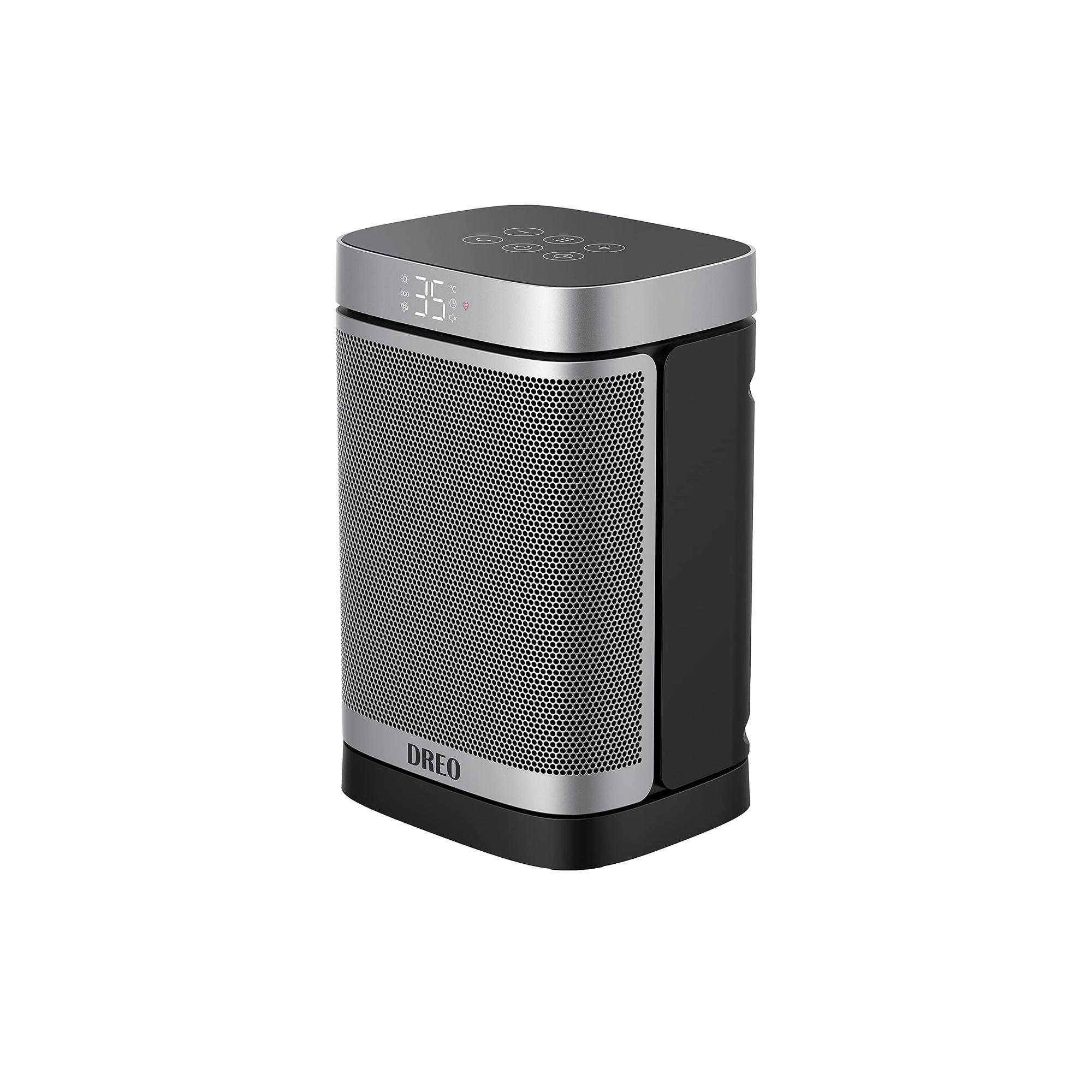
Best fan heater
The Dreo fan heater is quick to heat a room, oscillates for good heat distribution, has three fan speed settings, and can maintain a temperature of between 5-35°C. It's also relatively affordable, compact, and easy to move around the home. Overall, we think it's a great buy if you're looking for a quick blast of heat to take off the chill in a small, medium, or larger room.
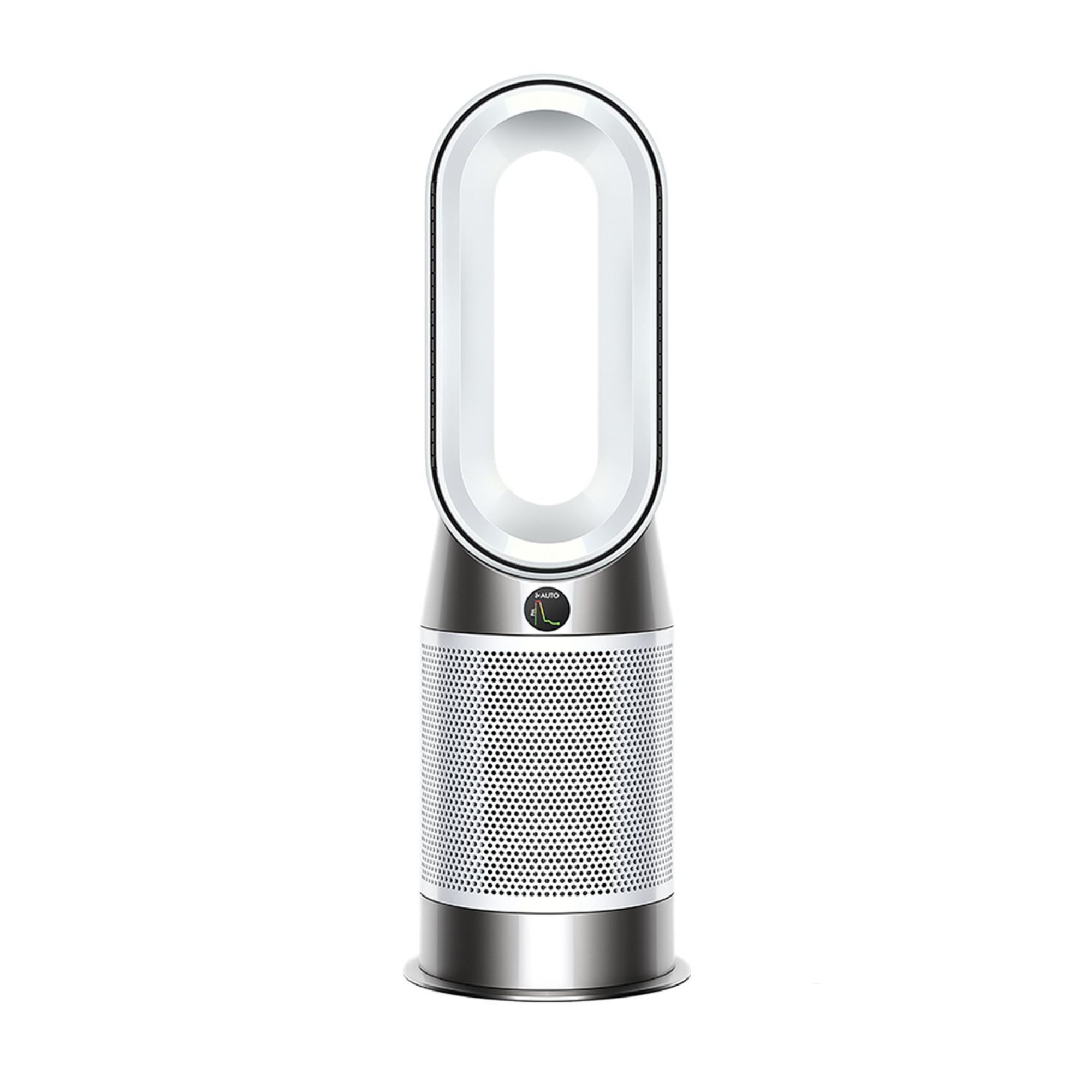
Best multifunctional
It's an investment, but the Dyson Purifier Hot+Cool HP1 offers year-round climate control with a 3-in-1 heater, fan and air purification functionality. The bladeless design is powerful and quiet, and the intelligent sensors mean you can simply set your desired temperature and leave it to manage your home's air quality for hassle-free operation.
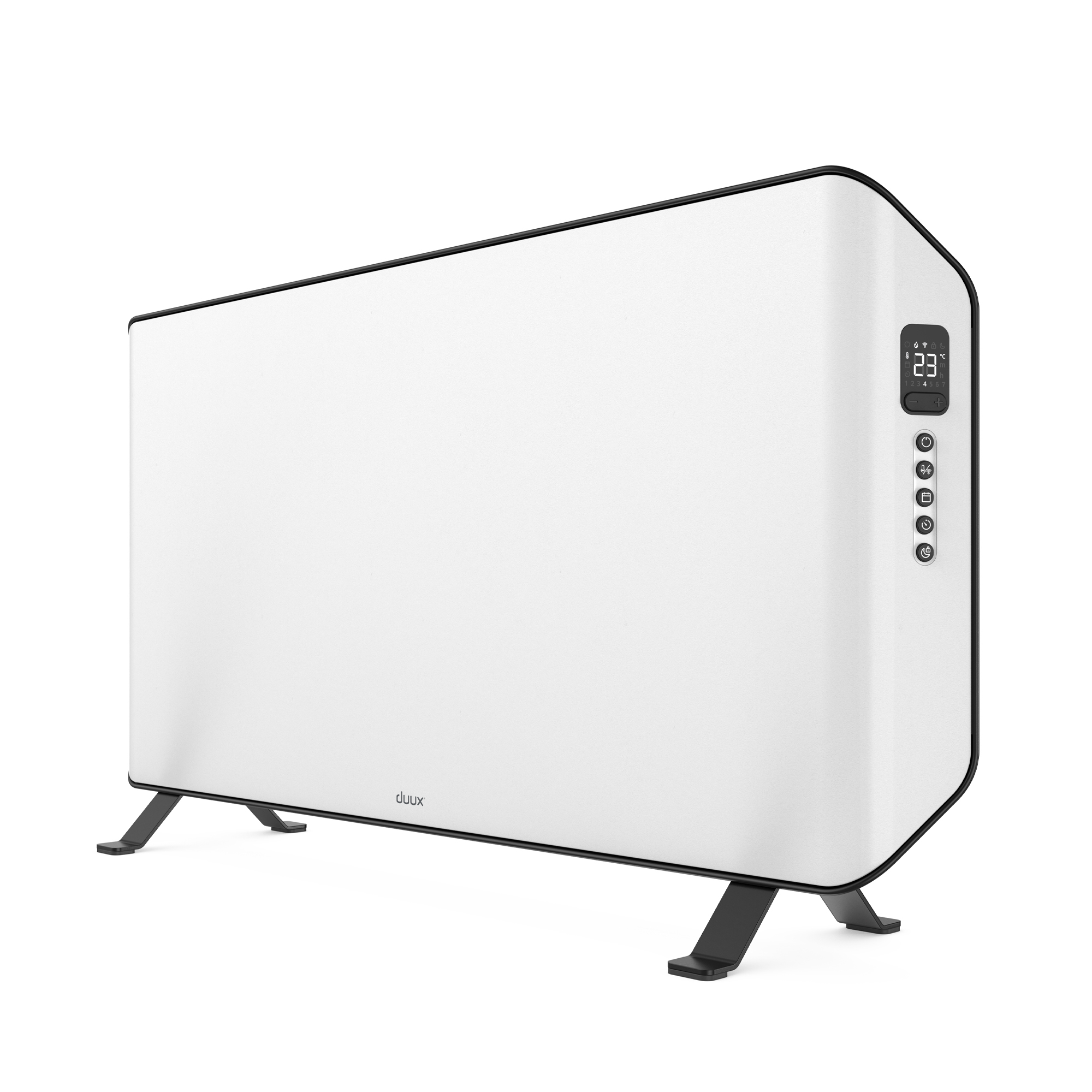
Best convector heater
A convector heater is slower to emit warmth than a fan heater, but, its operation is silent, and its steady heat can be more economical if you have it running for long periods, or if you have a large room to heat. The Duux Edge 1000 Smart Convector Heater is a cut above the usual electric convector, offering a stylish design and great functionality.
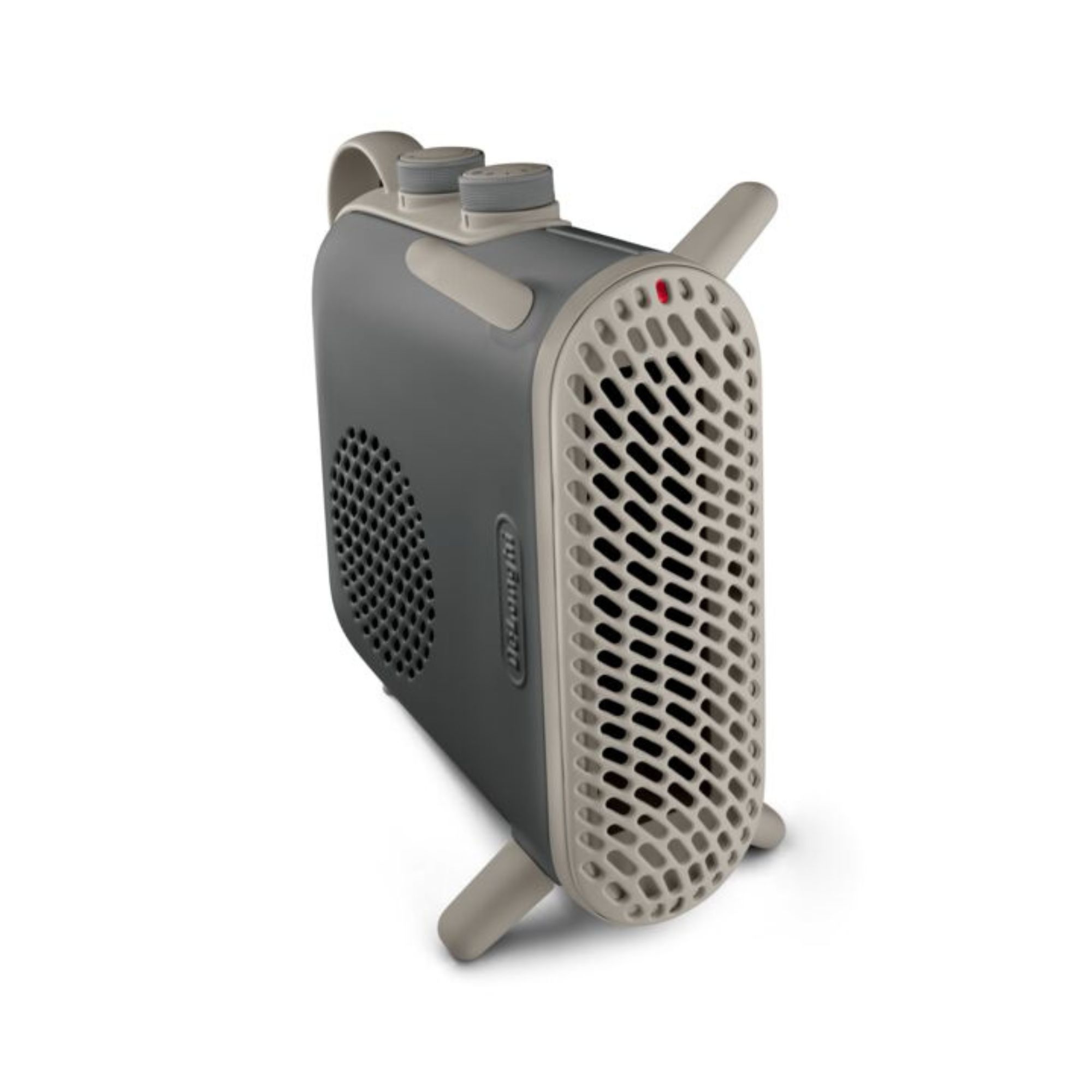
Best versatile
This fan heater is deceivingly powerful, stylish, and space-saving; three of our favourite attributes. It boasts a versatile design that lets you to place it either horizontally or vertically, allowing it to adapt to any corner of your home. It's easy to use and super quiet, making it the perfect addition to a bedroom or home office.

Best for small spaces
This compact fan heater simply plugs into a wall socket, making it super portable, easy to store, and great for small rooms that are short on floor space. An affordable price tag of under £25, plus low energy usage – and therefore low running costs – makes this plug-in heater our best budget buy if you only have a small area that you want to heat.
Best electric heaters 2025
Best electric heater overall

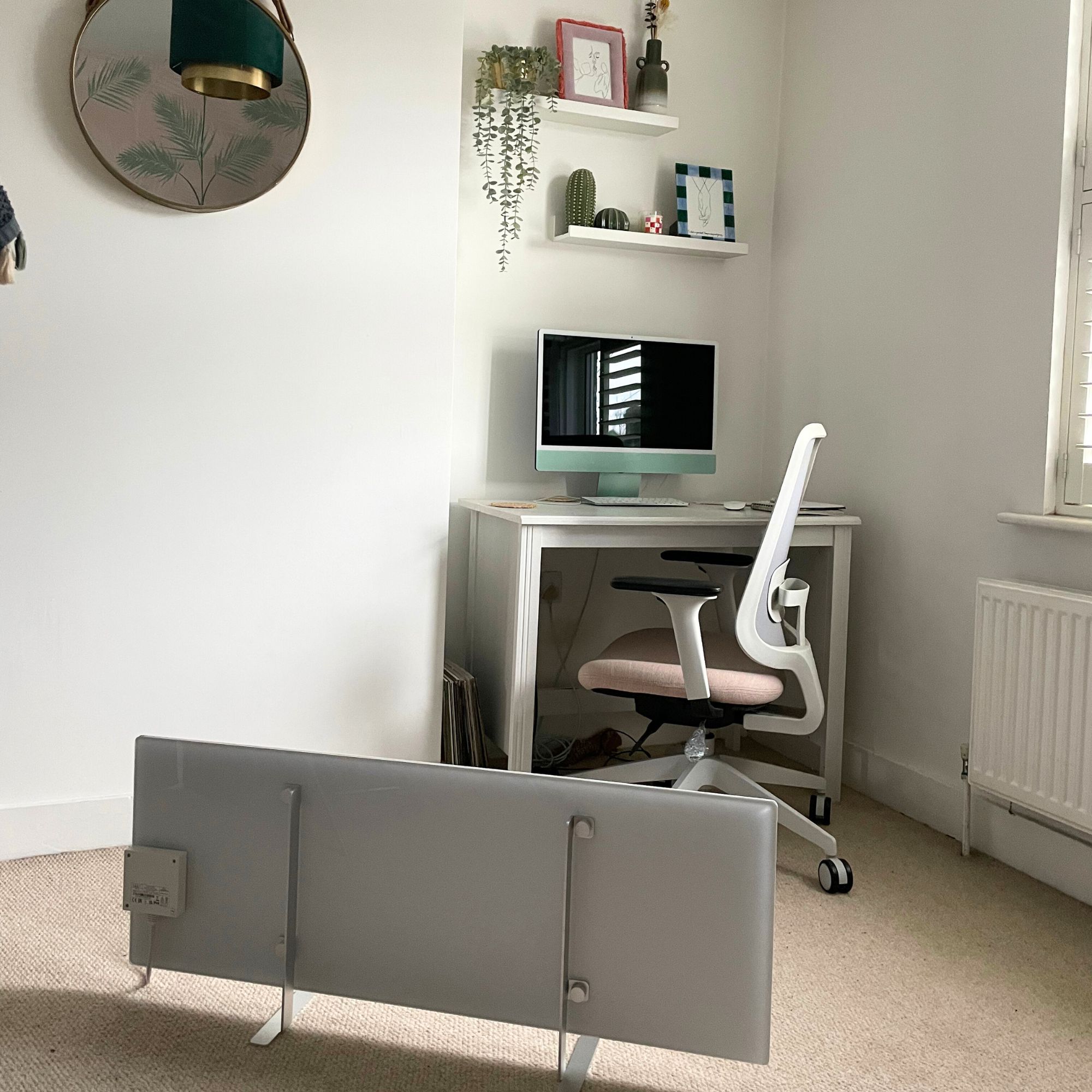
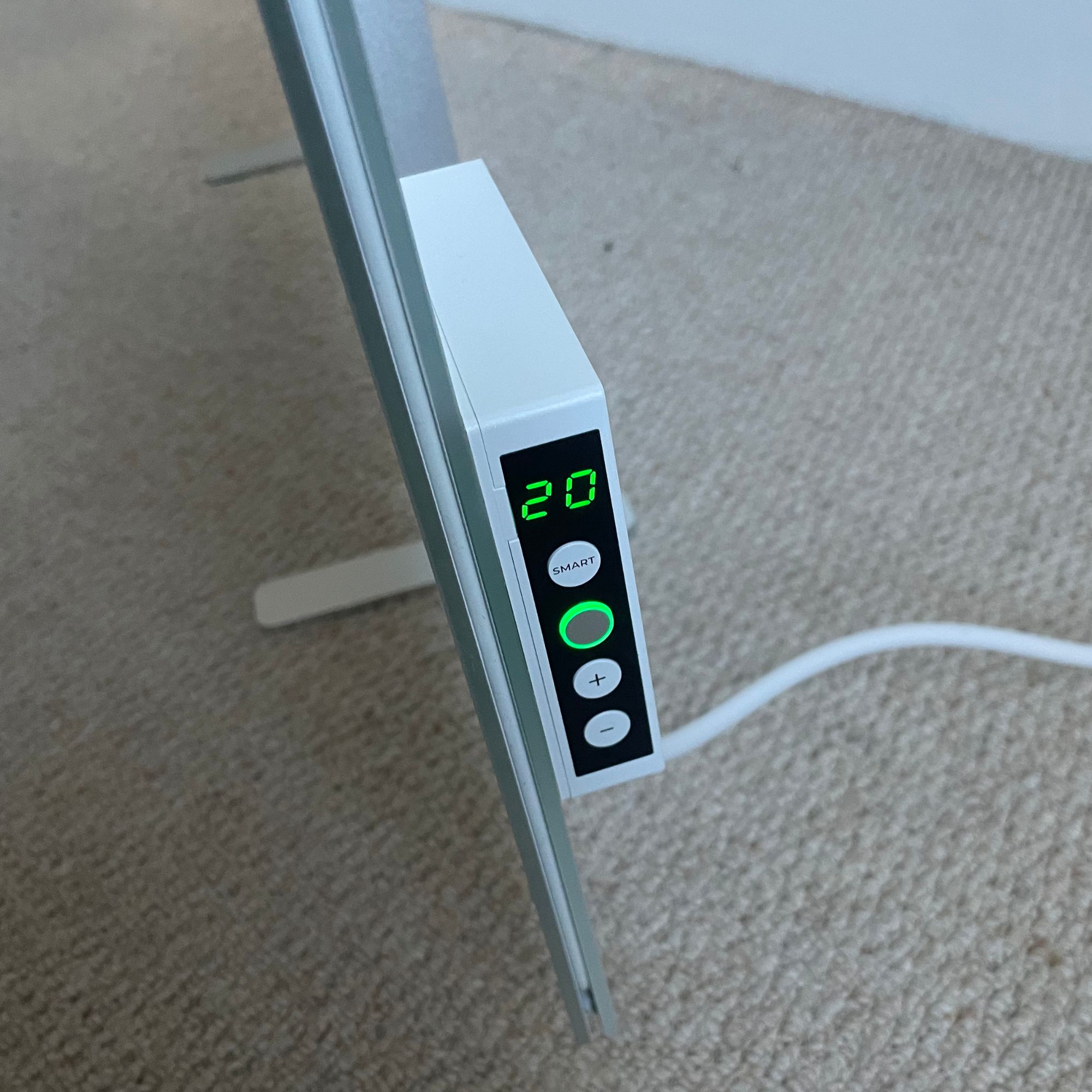
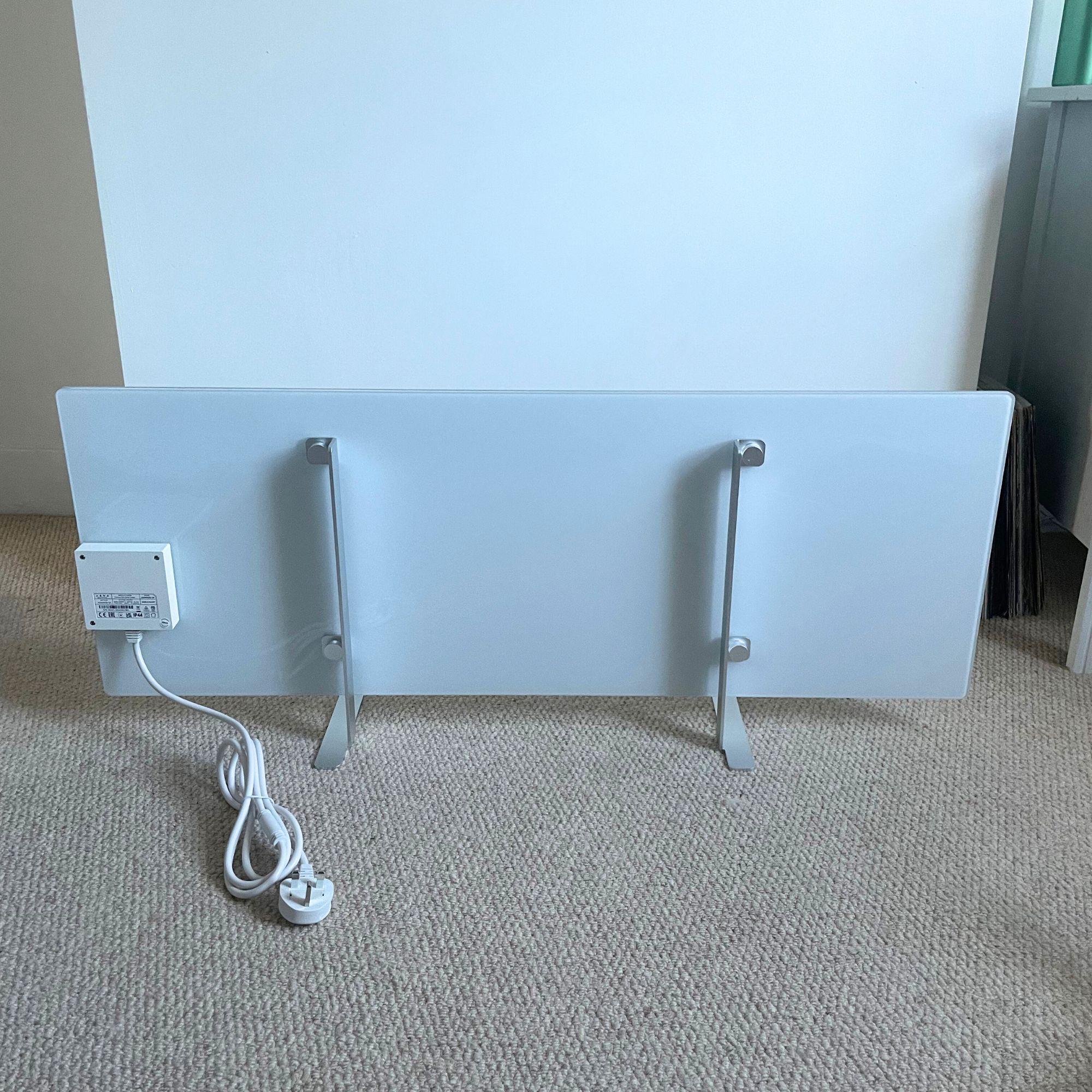
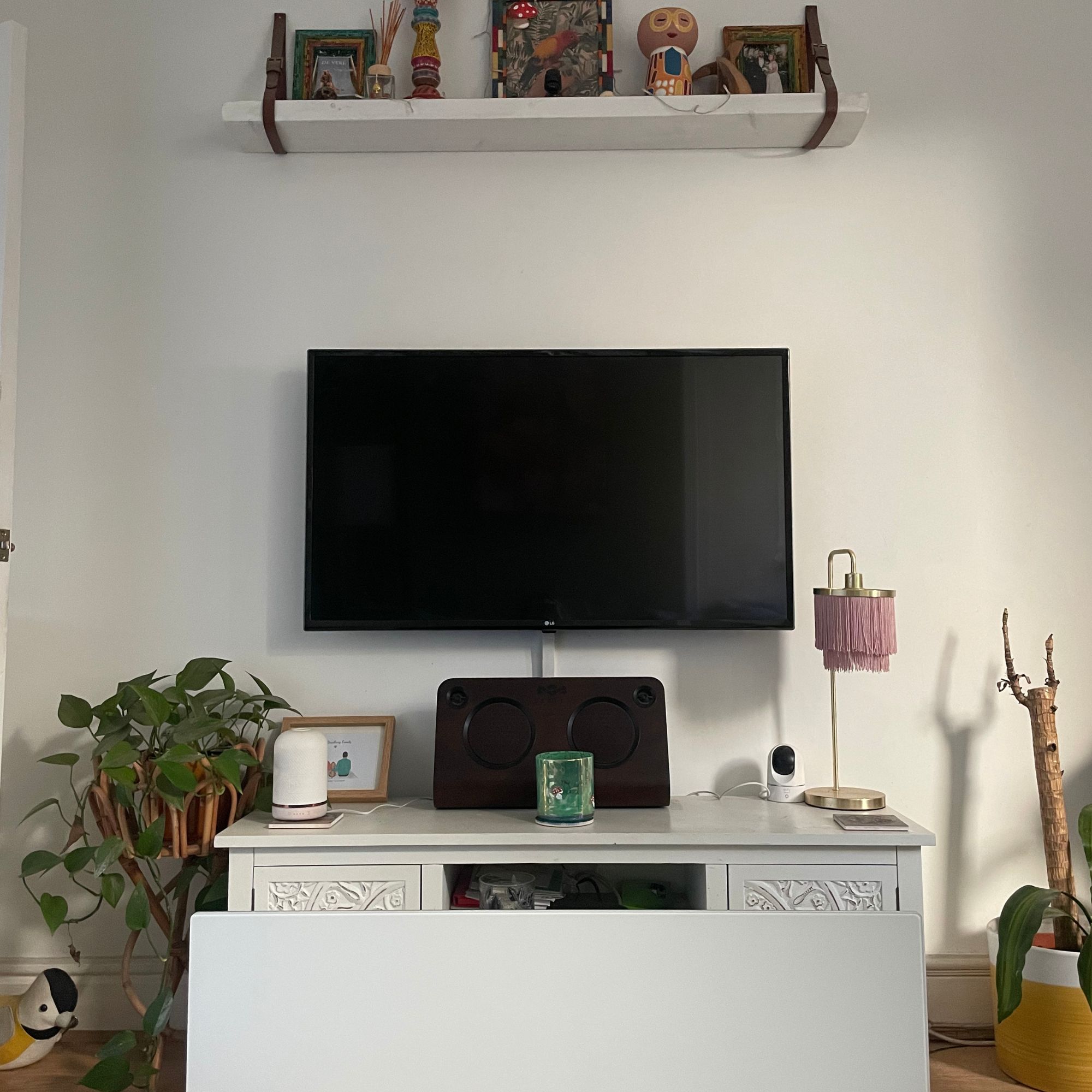
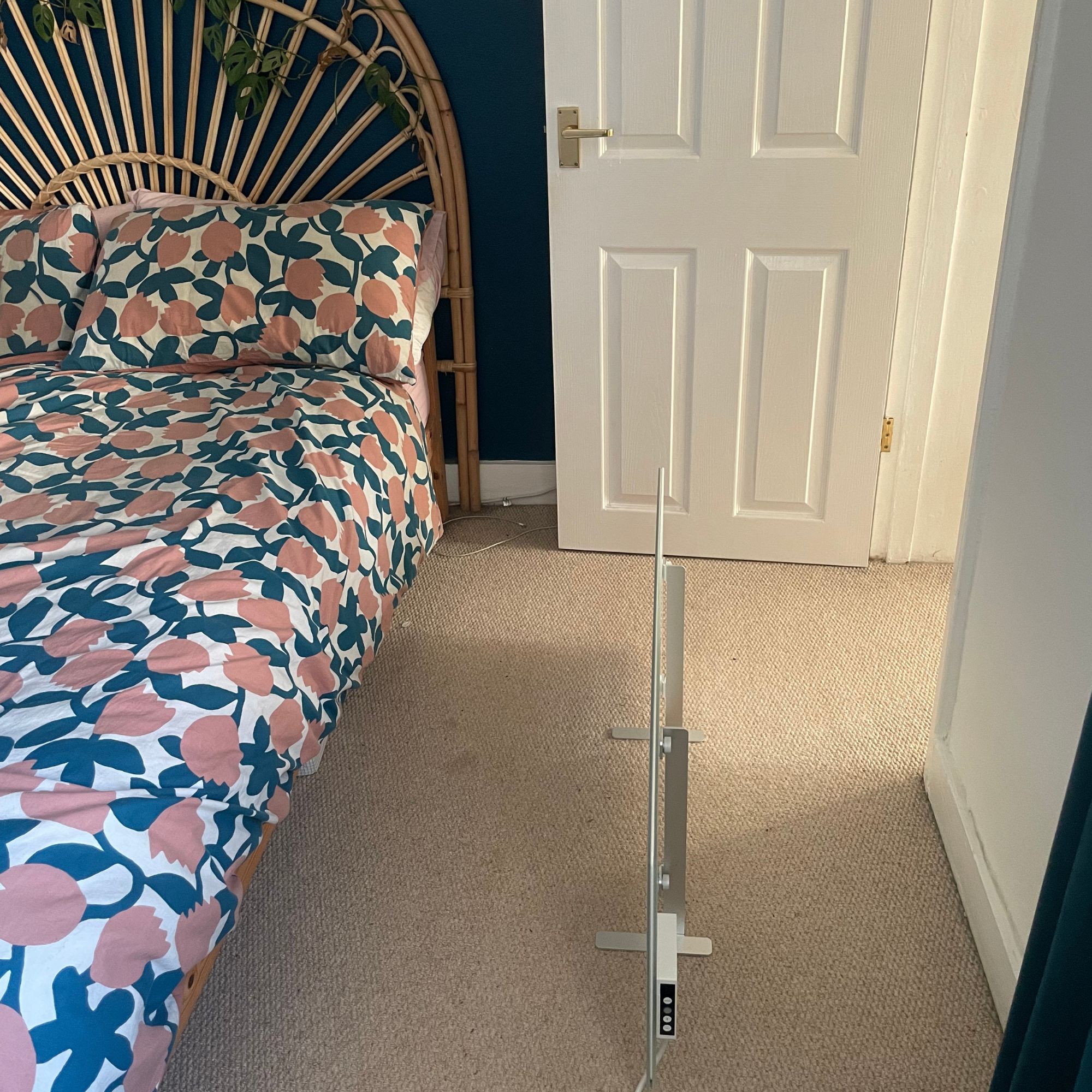
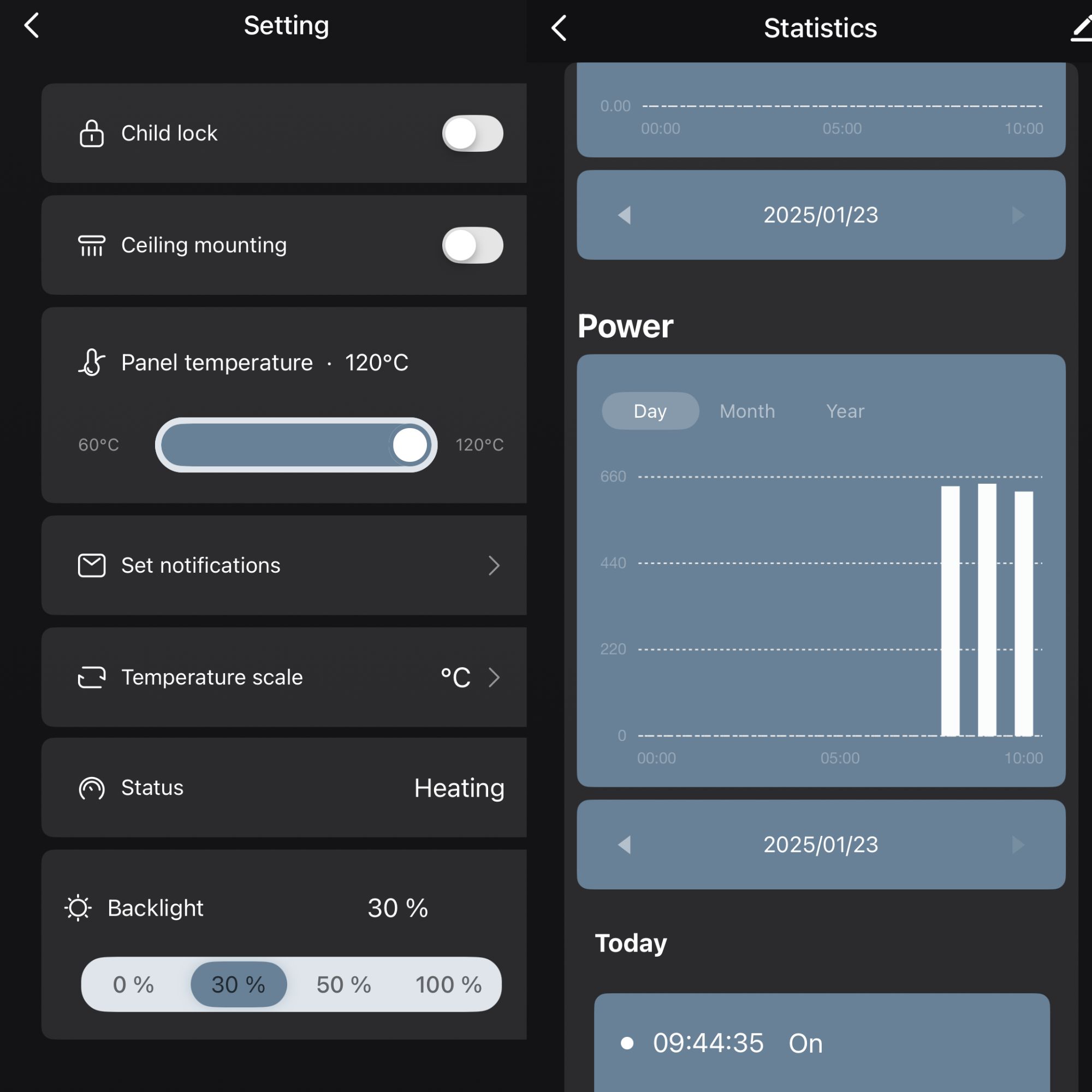
Specifications
Reasons to buy
Reasons to avoid
Design As far as electric heaters go, the AENO Premium Eco Smart Heater is arguably one of the most sleek and stylish ones out there. And while it's undoubtedly on the bigger side, what I loved most about this model is that it can either be mounted on the wall or left freestanding. Featuring a tempered 11mm glass panel, silver legs (if used), and an almost-invisible side control panel, it looks more like your average radiator than a bulky or ugly electric heater.
Ease of use While it takes a little while to download the AENO app and link up this smart panel heater, it couldn't be easier to use when it's all set up. Everything you need to control this electric heater is found on the app, and from there you can choose whether you want the 'constant heating' option or use the in-built thermostat to heat your room to a particular temperature. The app also offers a timer, the ability to create a heating schedule, Alexa or Google Assistant connection, and energy use statistics. However, you can also use the control panel on the side of the heater if you don't want to use the app.
Performance The AENO Premium Eco Smart Panel Heater heats up incredibly quickly, retains heat well when you turn it off, and offers an impressive heat output no matter which setting you choose. To test this power, I turned off the radiators in my home office and let the room drop down to 12°C overnight, and it took just 1 hour to raise the temperature from 12°C to 21°C. Without oscillation power, you do get to feel more heat when sitting or standing directly in front of it, but the combination of infrared and convection means that it heats both the room and the people in the room.
Noise levels One of the (many) things I loved most about this electric heater is that it was completely silent. It didn't make a single noise throughout testing - not when heating up, while in use, or when cooling down.
Energy use The AENO Premium Eco Smart Panel Heater is marketed as an efficient, cheap, and eco-friendly electric heater - and I found that to be true during testing. On one day, I used it for almost three hours, and during that time, it used 1.64kW/h. This worked out to £1.30 over the course of those three hours, or 43p per hour. This is extremely cheap for such a large and powerful electric heater.
Read our full AENO Premium Eco Smart Panel Heater review for more details.
Best fan heater

2. Dreo Space Heater
Our expert review:
Specifications
Reasons to buy
Reasons to avoid
Design Looking more like a smart speaker, this sleek grey and black fan heater does away with the white chunky lines of the traditional space heater entirely. Touch controls on the top and an LED display add to its premium feel. It's portable thanks to an integral handle at the back and can be set to rotate through 70° to help spread the heat around your space. Plus, it's pretty compact, so shouldn’t take up too much space on a table or the floor.
Ease of use The Dreo space heater is ready to go as soon as it is unboxed, with fairly straightforward instructions explaining the different modes. The heating mode is split into three levels, which need to be toggled with the plus and minus buttons, and there's an Eco mode that uses sensors to select the ideal heating mode depending on the desired room temperature you’ve set. This heater also comes with a remote control, the only niggle being it needs to be pointed directly at the heater for it to work – even small objects seem to block the signal.
Performance Fan heaters can often create hot spots in a room, but this is where the oscillation of the Dreo Space Heater comes into its own. Our tester, Rachel, found it brilliant at heating her office room from cold, with the warmth spreading throughout quickly. Another plus was the range of heat on offer – its thermostat meant she could set a temperature between 5-35°C, so there was never any risk of getting too hot and then having to open a window to cool the room down again. In terms of heating flexibility at an affordable price, it felt superior to the other fan heaters she tested.
Noise levels The Dreo Space Heater has a noise level of just 37.5dB (the oscillation raises this to 40dB). Rachel found it to be equivalent to the level of noise of the Beldray fan heater she tested – quiet enough to talk over but still noticeable. One other thoughtful feature is being able to switch off its electronic beeps.
Energy use Using its highest heat setting means the Dreo Space Heater uses 1500W of electricity. That means an hour’s constant use of the Dreo Space Heater, at a rate of 24.5p per kWh, would cost just under 37p. However, its lower settings are less costly, with medium heat (1000W) costing 24.5p an hour and low (900W) 22p an hour.
Best multifunctional

3. Dyson Purifier Hot+Cool HP1 Purifying Fan Heater
Our expert review:
Specifications
Reasons to buy
Reasons to avoid
Design One thing Dyson always nails is the design, and the Dyson Purifier Hot+Cool HP1 is sleek, stylish, and comes in a neutral white and silver colourway. The bladeless design is easily recognisable as a Dyson heater (and the best air purifiers), and it was a lot smaller than I expected. This was a nice bonus as the smaller size makes it easy to move around the house - and easy to tuck in the corner when it's not in use.
Ease of use There are two ways to control the Dyson Purifier HP1: via the MyDyson app or through the remote control. The app connectivity is arguably the better option of the two, as it allows you to set up timers and schedules, adjust the airflow and temperature, and explore the air quality graphs. Everyday operation of the heater is really simple, as you just toggle up and down to set your desired room temperature, and the Dyson's intelligent sensors will automatically turn the heater on if temperatures dip under your target setting, and off when the target temperature is reached to save on energy.
Performance The Hot+Cool HP1 has the widest temperature range of any electric heater we've tested, allowing you to set a target temperature of between 1-37°C. Dyson's powerful air multiplier technology also projects up to 290 L of heated air per second, which means it can heat whole rooms in just minutes. The added bonus of 350 ̊ oscillation also means that you can either target specific areas or heat a wider space.
Noise levels At 63 Decibels, this Dyson fan heater is one of the loudest electric heaters in this list - especially when it's on full power. At its quietest, it's still not as silent as we'd like, but it shouldn't be an issue for those who don't mind a bit of background white noise. The bladeless design also means there are no whirring fans, so the noise isn't jarring or unnerving. Instead, it simply sounds like gushes of air.
Energy use Dyson has not supplied information on the wattage of the Dyson Purifier HP1, but Dyson heaters generally cost more than the average electric heater to run when they're at full power. However, the intelligent sensor does mean you'll never use more energy than is needed to keep your home at your preferred temperature, as it will automatically switch to standby once your target temperature is reached, which can make it more economical in practice than super cheap models like the Beldray Flatbed Portable Fan Heater, which are either on or off.
Read our full Dyson Purifier Hot+Cool HP1 Purifying Fan Heater review for more details.
Best convector heater

4. Duux Edge 1000 Smart Convector Heater
Specifications
Reasons to buy
Reasons to avoid
Design Duux’s Edge 1000 Smart Convector Heater does a great job of overhauling the usual outdated convector heater design. It’s slim, glossy, beautifully designed and a world away from the basic looks of more affordable models, such as the Challenge convector heater further down this list. You can use it freestanding, but, ingeniously, you can also wall-mount this heater if you want to free up floor space. However it is worth noting that this heater isn't very portable – there’s no carry handle so it’s awkward to pick up, and it weighs in at a hefty 7.55kg.
Ease of use On delivery you need to attach the feet to this heater with a screwdriver, which – a little annoyingly – isn't included. Once that's done, you'll also need to connect the Duux Edge 1000 to your WiFi and download the Duux App to a smart device to access the full range of functionality. Whilst you can use the manual controls placed discretely on the side of the heater, they’re not the most intuitive, especially for setting a schedule, so you’ll need the instruction manual. Setting schedules and using the other functionality (such as preset modes) is a lot easier using the Duux App. Set aside a good half an hour to get this heater unpacked and set up.
Performance Besides good looks, the biggest plus point of this convector heater is the size of space it can comfortably heat – up to 20sq m – and that it has an IP24 rating meaning that you can use it in damp spaces. The fact you can also choose to wall-mount it via the included wall kit is another bonus. It also comes with 'open window detection' functionality (meaning it turns off if a sudden drop of 5°C in temperature within 10 minutes is detected, to save on wasted energy), a timer, and night mode, meaning you can leave it on a low heat to keep a bedroom toasty whilst the display dims so it doesn't keep you awake.
Our tester Rachel found the heat the Duux Edge provided was instant but gentle and could be felt about a metre above from being turned on. As it's a convector heater, it did take a while for the heat to diffuse throughout the space as there's no fan to push the warmth instantly into the room, but the upside is that this heater throws out warmth for a good length of time even after it's turned off. She also liked the fact that the Edge enabled her to set my desired temperature down to the exact degree.
Noise levels As this is a convector heater rather than a fan heater, operation is far quieter in comparison. The Duux Edge didn’t make any noise other than an occasional click when turning the thermostat on and off.
Energy use While the costs may vary depending on which mode you’re using it in (for example, there’s an eco mode only accessible through the App) the Duux Edge 1000 is fairly thrifty at its highest wattage use of 1000W, which currently costs about will be 24.5p an hour. That means that whilst it's more of an investment upfront than the Challenge convector heater, the Duux Edge convector heater is more energy efficient and costs less to run.
Best versatile heater

5. De'Longhi Capsule Fit Fan Heater
Our expert review:
Specifications
Reasons to buy
Reasons to avoid
Design The De'Longhi Capsule Fit Fan Heater boasts a stylish Italian design that is sleek and very modern-looking. In a grey and neutral colourway, it's good looking enough to not be an eyesore, and its space-saving, dual positioning design allows you to place it either horizontally or vertically to flexibly fit into any corner of your home. The cool-touch metal casing feels very robust and durable, and its rubber feet ensure that the heater is impact resistance when placing it onto any surface. It has an IP20 rating, meaning it's resistant to dust and is touchproof, but should be kept well away from liquids. The carrying handle is a nice touch, making it easy to pick up and move the heater into your spot of choice with no fuss.
Ease of use The Capsule Fit is super straightforward and easy to use. There's no assembly required – simply plug it in and you're ready to go. It utilises mechanical controls in the form of two dials; one to adjust the heating fan setting/speed and one to adjust the temperature. No faffing around with apps or complicated set-up with the convenient plug and play design.
Performance Considering the Capsule Fit's slimline and space-saving design, its power is nothing to scoff at. It's suitable to use in rooms of up to 72m³ and is equipped with three heating power settings; 1000, 1400, and 2400W. Each setting is very effective and even the lowest setting is enough to quickly heat up a room. For warmer months, it even has a cool air function, too. Although it lacks a timer, the Capsule Fit does have a safety thermostat, automatically shutting off the heater to prevent it from overheating. It does its job well, but we only wish it gave you a little more control.
Noise levels Compared to other fan heaters, the Capsule Fit is very quiet, irrespective of its fan speed, with its noise levels ranging from 43-48dB. According to De'Longhi, the heater is 60% quieter than a standard fan heater at its lowest and medium settings, making it ideal for use in a bedroom or home office. Our tester set up the heater in her home office while working at her desk, and it kept her toasty the whole time without disrupting her workflow and concentration. Even in the living room, it doesn't distract or overpower the TV, making it a seamless addition to any room I bring it in.
Energy use As with any heater, the cost to run will vary depending on the mode you're using it in. Its lowest setting of 1000W costs about 24.5p per hour to run with its highest 2400W setting costing roughly 59p per hour under the current energy price cap of 24.5p per kWh. Naturally, the cost to run the Capsule Fit on its max setting definitely adds up in the long-run, but during testing, we've always found the lowest setting more than sufficient enough to quickly heat a room and actually keep us warm after the fact.
Best fan heater for small spaces

6. Russell Hobbs 700W Ceramic Plug In Heater
Specifications
Reasons to buy
Reasons to avoid
Design One of the most appealing aspects of the Russell Hobbs Plug-In Heater is that it’s super compact. This design simply plugs directly into an electrical socket which means it requires no floor or table space, making it perfect for a small room, plus there are no unsightly cables to navigate. It feels robust, and whilst it's not quite as sleek in design as the Dreo and Duux fan heaters we've tested, we love that it’s so compact, which also made storage a dream.
Ease of use There’s no assembly required with the Russell Hobbs 700W Ceramic Plug-In Heater – just plug it in. However, getting the ideal positioning can prove tricky. The heater needs enough clearance space to operate, which means positioning it 30cm above floor level and leaving 50cm between the heater and any side walls. In case you don't have enough clearance below a wall socket, you can rotate the heater section through 90°, however, this does locate the controls on the righthand side making them a little more difficult to access.
The controls themselves consist of an on-off switch and three buttons; a plus and minus button for raising and lowering the desired temperature (within a 15-30°C range), and a Mode button for changing the fan speed, alongside an LED display. We found the controls a little difficult to navigate as they aren't marked very clearly, and the operating instructions left a lot to be desired, with the instructional manual not always describing the functionality accurately.
Performance At first, we found the reach of the Russell Hobbs 700W Ceramic Plug-In Heater to be limited – we found we got about a three-metre range of direct heat after the heater had been running 10 minutes or so. However, when left running for about half an hour, the heat diffused around a metre further, warming the whole 15 sqm room after about 45 minutes. Considering this compact heater is far smaller and less powerful than all the other heaters we tested, we were impressed by its performance.
Noise levels There’s no stated dB for this heater but it’s not noisy when running. The high fan speed has more of a whine, so if you find it obtrusive, the lower speed may be more suitable.
Energy use The compact Russell Hobbs 700W Ceramic Plug-In Heater is fairly inexpensive to run compared to larger heaters. Its highest setting uses 700W, which means it costs 17p an hour to run at a rate of 24.5p per kWh. That makes it one of the cheapest electric heaters to run out of all that we've tested.
Best for desk
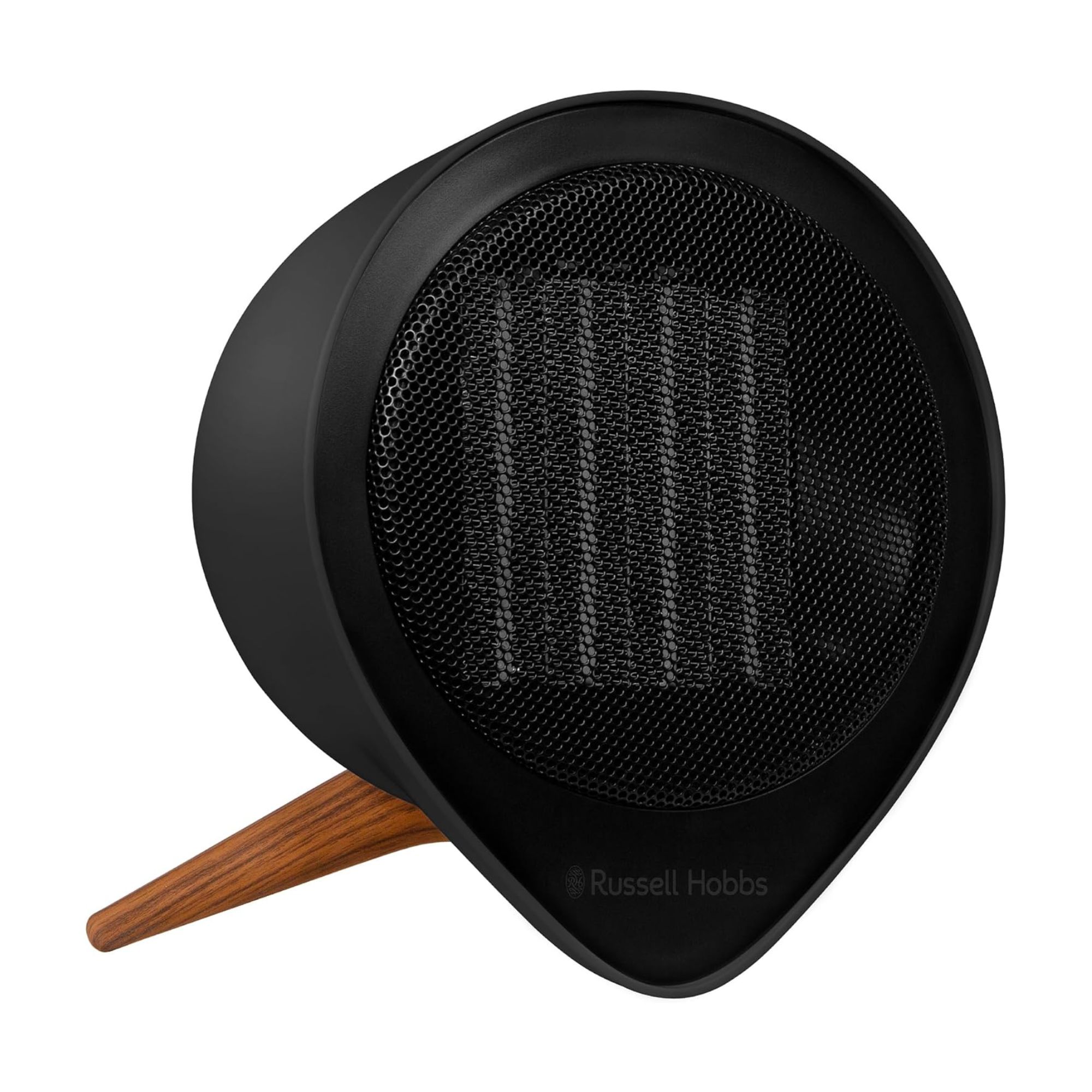
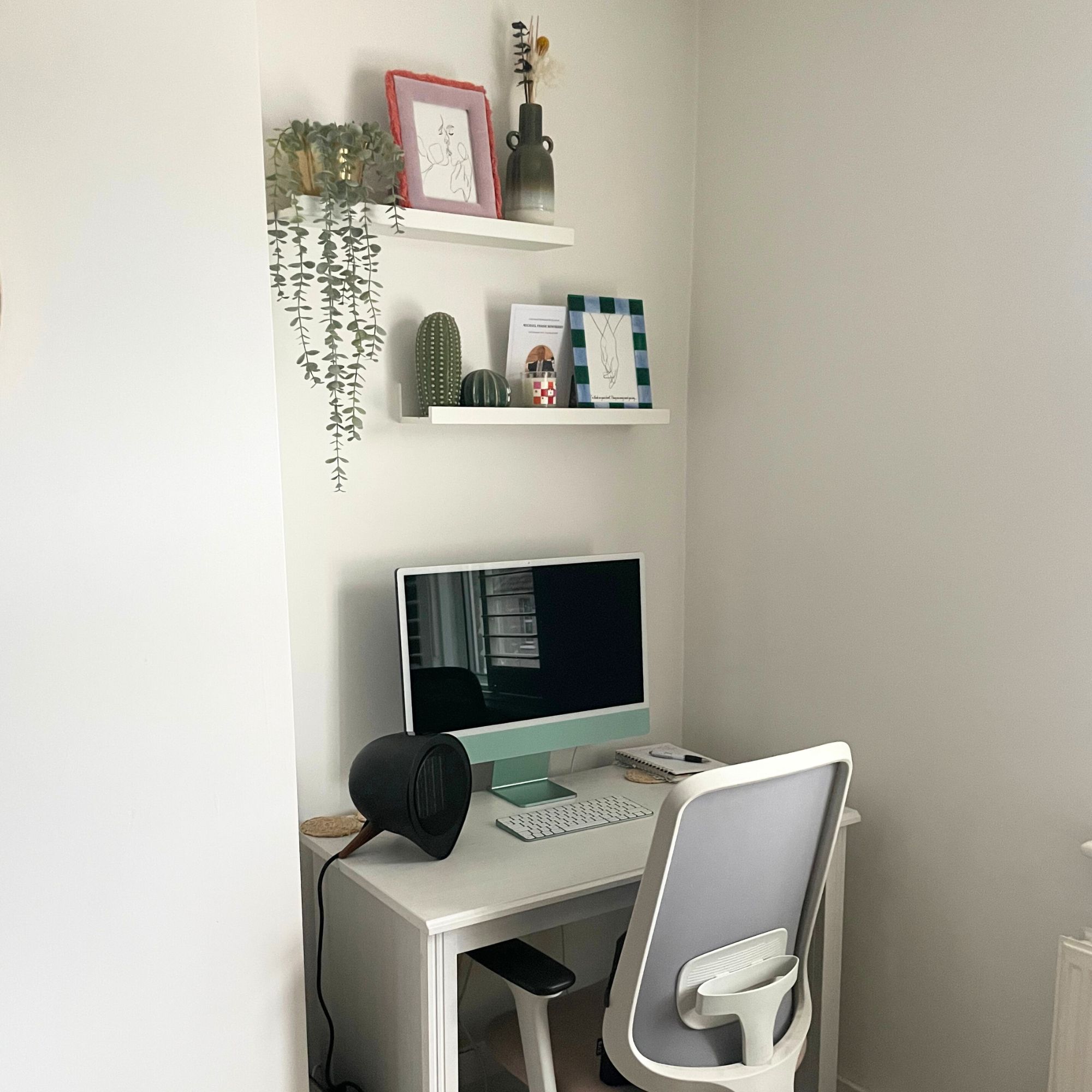

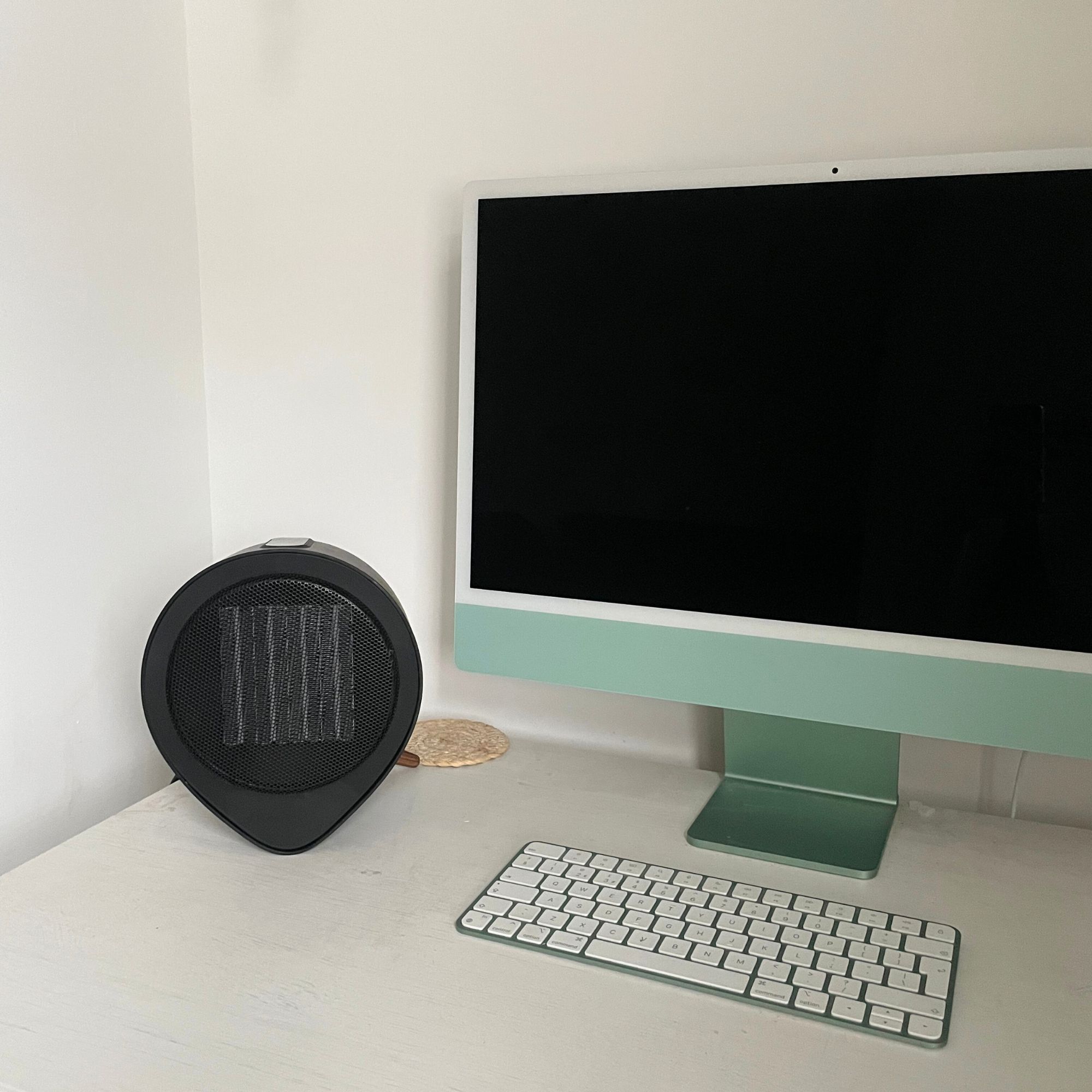
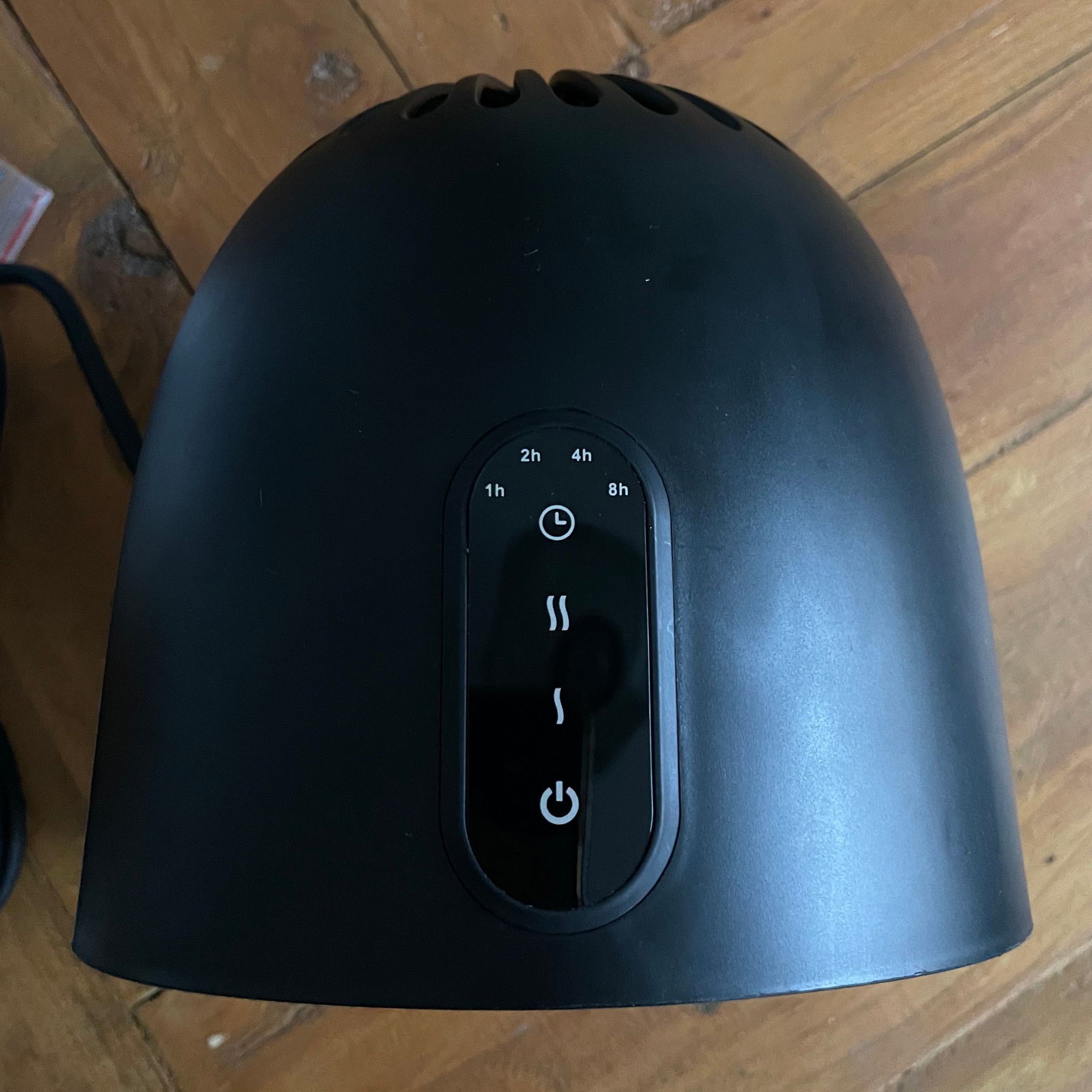
7. Russell Hobbs 1500W Retro Tripod Mini Ceramic Heater
Our expert review:
Specifications
Reasons to buy
Reasons to avoid
Design As the name suggests, this electric heater offers a retro design I found to be incredibly stylish. And while it's small enough to sit on a desk, it is quite deep - so that's something you should consider if you're looking to pop it on a narrow shelf. You can also buy it in a white colourway if you'd prefer, but both options come with the sleek wooden legs.
Ease of use This electric heater couldn't really be any easier to use if it tried. All of the controls can be found on the top of the heater, from the on/off button to the heat mode and the timer function. That's all there is to it!
Performance I wasn't expecting a huge amount of power from this desktop electric heater, but I was pleasantly surprised when I was not only able to heat myself while working from home, but also the whole room. Like all ceramic fan heaters, it did cool down incredibly quickly when turned off, but it heated up in seconds and provided a constant power that was obvious from right in front of the heater and on the other side of the room. You can also choose from two heat options, depending on your preference.
Noise levels One thing about ceramic heaters is that they can be loud, and this was also the case for this Russell Hobbs offering. When I had music on in the background, it did become white noise that didn't interrupt my workflow at all. But if I didn't have music on, it was quite irritating.
Energy use This electric heater is fairly efficient, and I found that an hour's use cost me 25p an hour on its lowest setting and 41p on its higher setting. Of course, there are cheaper options on the market, but these might not have the same impressive power.
Read our full Russell Hobbs 1500W Retro Tripod Mini Ceramic Heater review for more details.
Best stylish
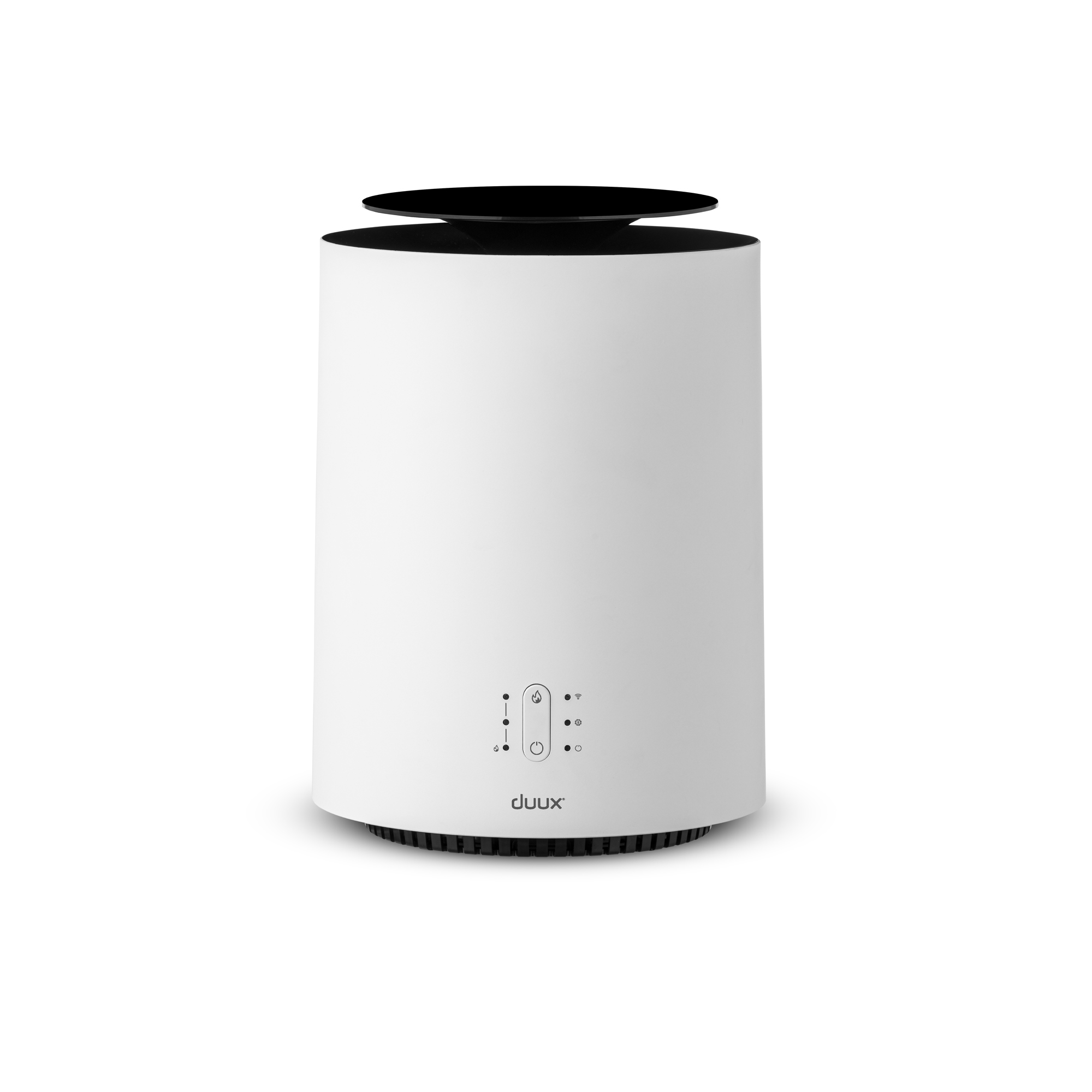
8. Duux Threesixty 2 Smart Fan Heater
Our expert review:
Specifications
Reasons to buy
Reasons to avoid
Design Whilst cheaper fan heaters focus purely on function, the Duux Threesixty 2 Smart Fan Heater adds style to the mix. It’s by far the most stylish electric heater we've come across, with a minimalist cylindrical design and modern matt finish in white or grey. Compared to most of its competitors at this price point, this indoor heater is definitely the most design-led.
Ease of use Just like its overall design, the Threesixty's controls are also minimal. On the heater itself, there's simply a single rocker-style button that turns it on and off, as well as raises the fan speed. On either side of the rocker button, LED lights indicate whether you have the heater running in boost mode (speeds medium and high) or eco mode (low speed), as well as if it’s connected to the WiFi. And you do need WiFi connection to make the most of this heater.
In order to access the heater's full functionality, you need to download the Duux App onto a smart device – like a phone or tablet – so you can control the heater remotely. Via the App you can set timer schedules, turn the heater on and off, raise the power and set the ideal temperature using the thermostat. Without the App, you lose some of this functionality, which is a bit of a shame; you’ll only be able to change the heat/speed and turn it on and off manually.
Performance Named for its 360-degree heat distribution, the Threesixty 2 Smart Fan Heater definitely lives up to its moniker. Duux says that 'In boost mode, the Threesixty can heat up a room of 30m2 twice as fast as conventional heaters, thanks to its efficient PTC heating element. The air outlet makes sure the heat is evenly distributed in 360 degrees'. Thanks to the App, our tester Rachel was able to monitor how quickly the room heated up as it showed the current room temperature as well as what she had set it to reach. On most days, the heat made it to the other side of the unheated room in about 10 minutes. While it was always much toastier close to the Threesixty 2, it was never an uncomfortable blast of warmth around her legs like older fan heater models can produce. The other plus was that it directed the heat upwards and outwards rather than just in one direction.
Noise levels The Threesixty 2 Smart Fan Heater can be quite noisy on the high setting, but is far less obtrusive on low, which is more like a background murmur. Its stated noise level is 56dB which is pretty high compared to many heaters we've tested. Rachel found it to be noisier than the Russell Hobbs Plug-In Heater and Dreo Fan Space Heater, but not excessively so.
Energy use Run on its lowest setting (800W), the Threesixty 2 Smart Fan Heater shouldn’t use too much power, costing just under 20p an hour. However, prices creep up on the medium (1200W) and high settings (1800W), costing 29p and 44p an hour respectively at a rate of 24.5p per kWh. Depending on how you use it, it could be one of the cheapest or priciest electric heaters to power in our round-up.
Electric heater comparison at a glance
Model | Price | Ideal Home Rating | Brand Trustpilot Rating | Type | Wattage |
£199 | 5 | 3.6 | Panel | 700W+ | |
£59.99 | 4.5 | 4.1 | Fan | 1500W | |
£549.99 | 4.5 | 3 | Bladeless | Not supplied | |
£169.99 | 4.5 | 2.1 | Convector | 1000W | |
£59.99 | 4 | 4.4 | Fan | 2400W | |
£24.99 | 4 | 4.1 | Ceramic | 700W | |
£24.99 | 4 | 4.1 | Ceramic | 1500W | |
£119 | 4 | 2.1 | Fan | 1800W | |
£30 | 3.5 | 4 | Convector | 2000W |
Best of the rest
Dyson Purifier Hot+Cool Formaldehyde HP09 Purifying Fan Heater (⭐⭐⭐⭐½)
Although this electric heater, fan and air purifier combo offers many of the same features as the Dyson above, this one has the added bonus of being able to filter formaldehyde. As such, it's slightly pricier.
Blueair ComfortPure 3-in-1 T10i Air Purifier (⭐⭐⭐⭐½)
Although it's technically one of the best air purifiers, this Blueair model can also serve as a dedicated electric heater or fan. It also offers 350° oscillation and allows you to set timers to suit your heating schedule.
Dunelm 500W Plug in PTC Heater(⭐⭐⭐⭐)
Slightly less powerful than the Russell Hobbs model above, this Dunelm plug-in heater does have the advantage of being cheaper at just £18. It's ideal for plugging in and taking the chill off individual rooms.
SpeedComfort Radiator Fan (⭐⭐⭐⭐)
Although it's not technically an electric heater, this product can improve the efficiency of your heating system. In fact, our tester found that she was able to comfortably reduce her thermostat by two degrees, which can make a huge difference to energy bills.
How we test the best electric heaters
At Ideal Home, we take how we test very seriously. We only want to recommend products that we have hands-on experience with, which is why we follow a strict testing protocol to understand the ins and outs of every product that comes into our hands. To compile this guide, we made sure to test the electric heaters in real homes so we could understand how they'd fare for real-life customers.
During this reviewing process, we observed how quickly the electric heaters heat up, how effectively they heated specific rooms, how much they cost to run, and how noisy they were while running.
As well as testing out the heating functionalities, we also took note of the overall size and appearance of each electric heater as well as the general ease of use and the storage and portability to help potential customers better understand how well it would suit their home and their overall space.
Another important aspect of our testing process involves comparing these models against other electric heaters on the market. This allows us to directly compare how different brands, different sizes, and different types of electric heater fare in these home environments.
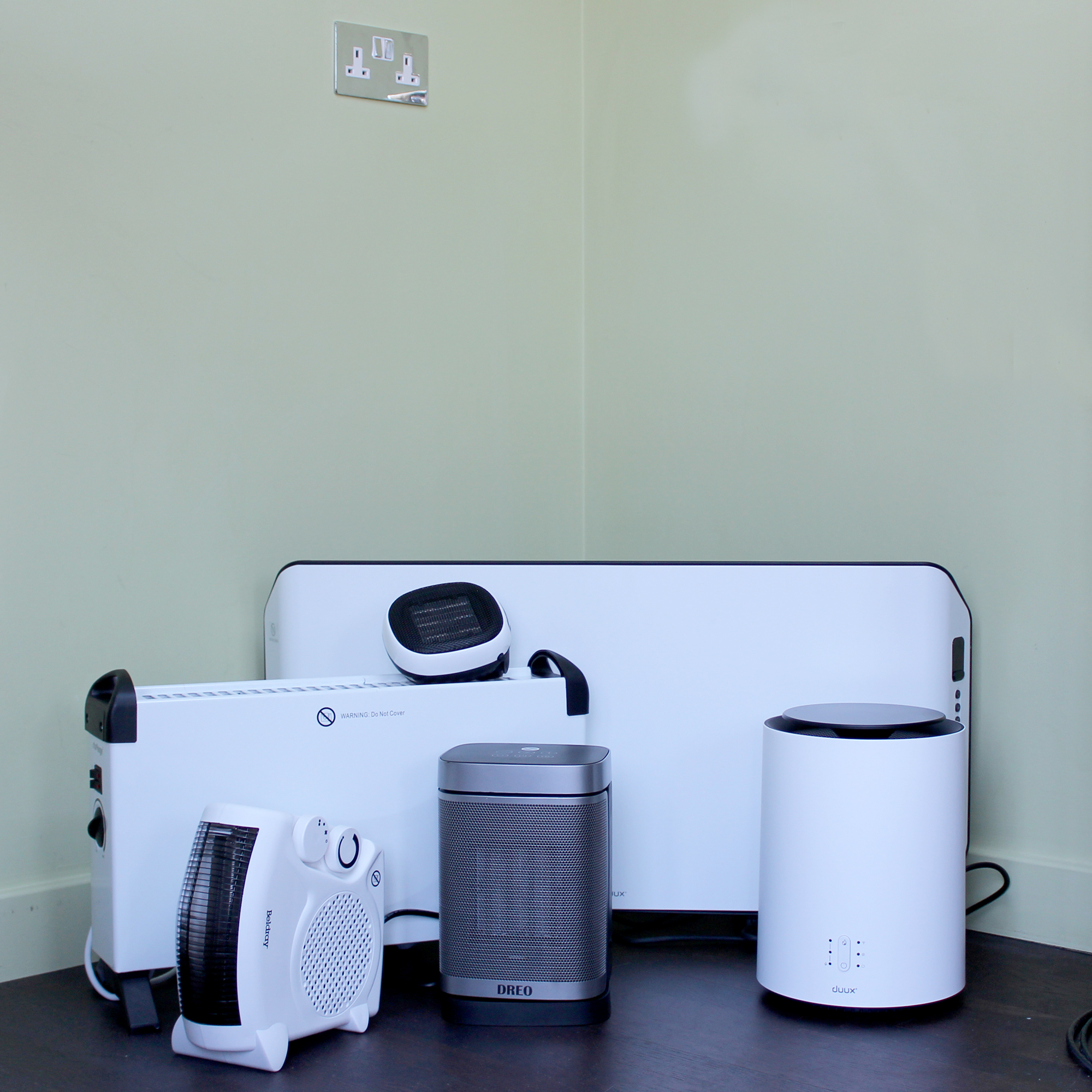
With all that taken into account, I’ve been able to assign each electric heater a dedicated Ideal Home star rating. They are as follows:
5 stars - an impressive electric heater that does exactly what you expect and cannot be faulted in any way.
4.5 stars - a high-quality and hard-working electric heater, but it leaves us wanting a bit more, so it doesn’t quite hit the 5-star mark.
4 stars - an amazing electric heater that is worth your money but may need some fine-tuning before it suits every customer and every home.
3 stars - a good electric heater that works well but doesn't blow us away with its specs or price tag. In some cases, it may not heat a room as effectively as competitors.
2 stars - an affordable electric heater that will suit all budgets but is under-specced and lacks key heating features.
1 star - we would not recommend this electric heater, as it is underwhelming and does not work as intended.
That said, after extensive testing and deliberation, I think the above are the best electric heaters currently available on the market. I believe these options will (unless otherwise stated) suit a wide range of homes and requirements and offer respite from the cold when needed.

Loving every area of the home, interiors journalist and freelance reviewer for Ideal Home Rachel has a passion for any gadget that makes life easier.
Plus, working from home in an unheated outdoor office meant that she was the perfect person to test the efficiency of many of these electric heaters.

Lauren is the Content Editor for House Manual, and it's her job to test countless home appliances, from the best vacuum cleaners to the best mops and the best electric heaters.
As Lauren works from home in a chilly Victorian home, she was able to test the full capabilities of many of the electric heaters on this list to see how they fared.
How to choose an electric heater
Warming up your home starts with choosing the right electric heater for the job, but they’re all different. So, there are many things you should know before buying an electric heater. From the type of heater to the size and heating mechanisms, they all have their advantages and disadvantages that will suit a variety of homes. That’s why I’d always suggest understanding how to choose an electric heater to reduce the chances of making any electric heater buying mistakes - and these are the things you need to consider:
The type of electric heater: However, there are three main types of electric heaters. These include fan heaters (which uses a fan to push warm air out into a room), convector heaters (which looks more like a traditional radiator and uses convection to warm up the air surrounding them) and halogen heaters (which uses incandescent light bulb that creates infrared heat).
The wattage: This will determine the heat output and the overall power of the appliance and will also impact how much it costs to run an electric heater - which is something to consider if you’re looking for the cheapest electric heater to run.
The best way to determine how much wattage an electric heater has is to look at the product specs. You may also see this information laid out in W (watts) of kW (kilowatts). Ultimately, the lower the wattage, the cheaper it will be to run - but it may not offer you what you want in terms of power and heat.
Convector heaters are typically the most economical. Some only use 1kW of power on maximum – compared to 1.5-1.8kW of some fan heaters – and even the ones that use 2-3kW have the advantage that they’ll carry on warming your space even after they’re turned off. So, it’s best to decide which is more important to you.
The noise level: It’s unlikely that you’ll find an electric heater that is completely silent - but there are some that are quieter than others, which is something you also need to consider when choosing an electric heater. While oil-filled radiators and convector heaters can often make clicking and whirring noises, they’re typically on the quieter end of the spectrum. However, a fan heater can be noisy, especially when running at higher speeds.
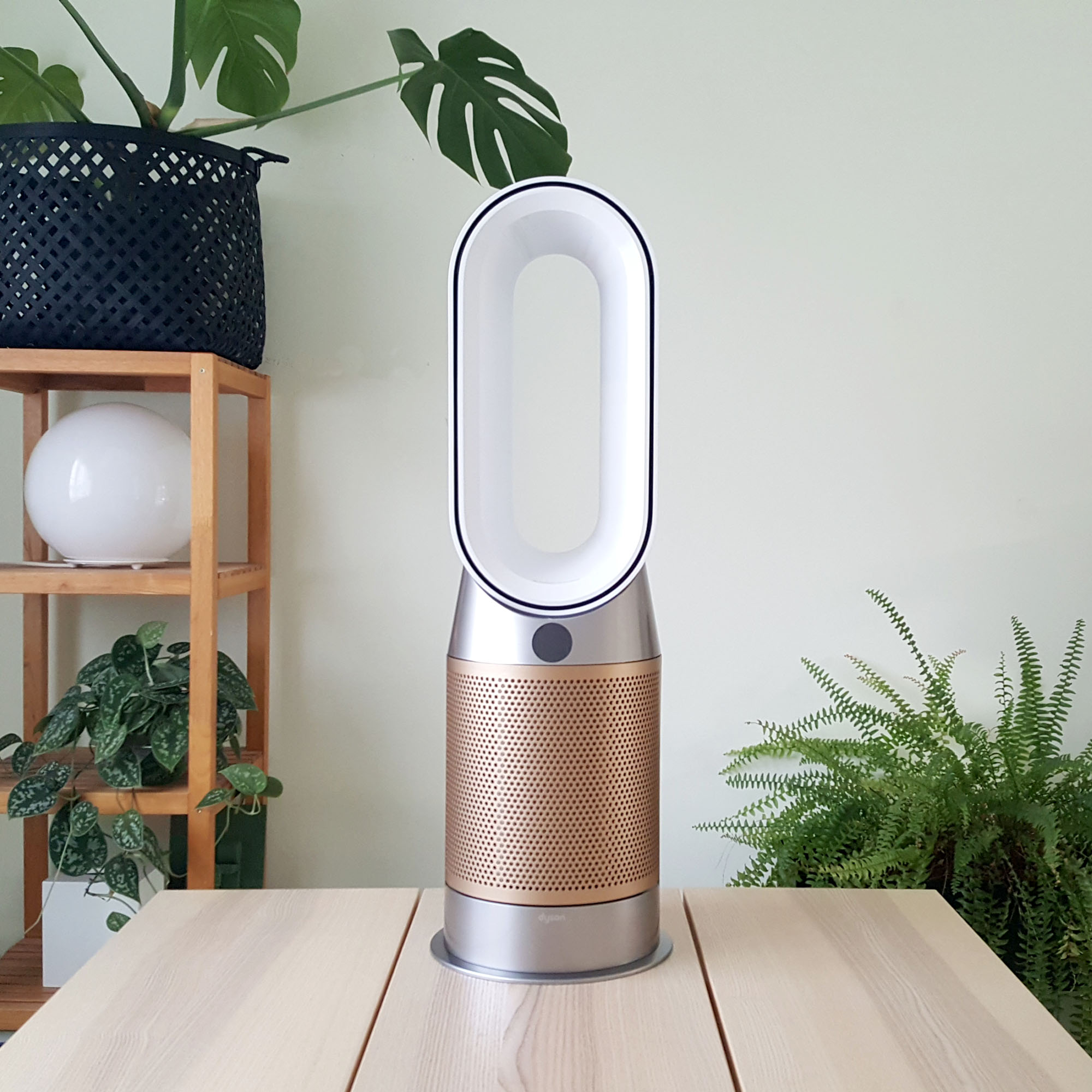
Heat retention: Electric heaters with impressive heat retention will continue to heat your home even when it’s not turned on - something those who want to save energy will enjoy. Typically, a fan heater is a good option for quick bursts of heat rather than steady prolonged use as it tends to cool down shortly after it’s been turned off. Halogen heaters are the same, as they won’t retain heat after use. And while convector heaters are generally slower to warm up, this also means that they are slower to cool down - which means that they retain heat a lot more than fan heaters.
Portability and storage: If you live in a small home and don’t have a lot of space to either use or store an electric heater, it’s well worth taking some time to look at the measurements and understand how big it really is. In some cases, it may be that a personal or desk heater would suit you best as it won’t take up too much space and can be stored when not in use.
Additional features: Many of these features can be extremely helpful when using an electric heater at home. It could be that you buy an electric heater with a timer or one that offers an anti-tip feature to keep any children or pets safe in the home. These extra features will always be found in the description of the product, so double-check that these work for you and your needs.
Price: While it’s certainly possible to find an electric heater for an affordable price, it’s important to note that the cheaper items will typically be less powerful and potentially have fewer features. Because of this, we'd always suggest deciding what type of electric heater you want before deciding how much you’d realistically be willing to spend on a new electric heater. This will allow you to narrow down your search and choose something that doesn’t go over budget but still matches your needs.
FAQs
What heater does Martin Lewis recommend?
Martin Lewis doesn't recommend a specific heater, but he does recommend changing your heating practices to keep yourself and your home as warm as possible over the winter. For example, he urges those who want to save money at home to 'heat the human, not the home.'
This means using the likes of the best electric blankets, hot water bottles, and portable heaters to heat the rooms you're in, rather than cranking up the central heating to heat the whole house.
However, that doesn't mean that we can't turn the heating on at all. Martin Lewis just suggests turning it on when we really need it, rather than having it on all the time just because it's cold outside.
What is the most efficient electric heater?
If you’re looking for fast distribution of warmth, a fan heater can’t be beaten. They’re ideal for chasing the cold away instantly, and, if you choose one with a ceramic element rather than metal, it’ll heat up faster, requiring less energy initially to get hot.
However, if it’s energy efficiency over long periods that you're looking for, a convector heater is probably the better choice, consuming less energy over an average day than most fan heaters. Ceramic heaters should also be considered, as they can heat a room very quickly and retain the heat when they're turned off. You can read our ceramic heater vs fan heater debate for more information.
Are plug-in ceramic heaters cheap to run?
Plug-in heaters are generally much smaller, to accommodate being plugged directly into the plug socket. This typically means that they have a smaller wattage and are cheaper to run. However, they will also take much longer to heat a room, so you may find that you need to keep it on for longer for it to make the desired impact. As a result, you may find that it’s cheaper to buy another type of electric heater that suits your needs better for a similar running cost.
Sign up to our newsletter for style inspiration, real homes, project and garden advice and shopping know-how

Lauren Bradbury has been the Content Editor for the House Manual section since January 2025 but worked with the team as a freelancer for a year and a half before that. She graduated with a Bachelor’s degree in English and Creative Writing from the University of Chichester in 2016. Then, she dipped her toe into the world of content writing, primarily focusing on home content. After years of agency work, she decided to take the plunge and become a full-time freelancer for online publications, including Real Homes and Ideal Home, before taking on this permanent role. Now, she spends her days searching for the best decluttering and cleaning hacks and creating handy how-to guides for homeowners and renters alike, as well as testing vacuums as part of her role as the Ideal Home Certified Expert in Training on Vacuums, having spent over 110 hours testing different vacuum models to date!
- Jullia JosonJunior Writer
- Rachel OgdenContributor
- Amy LockwoodSleep Editor
